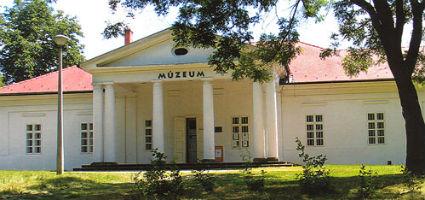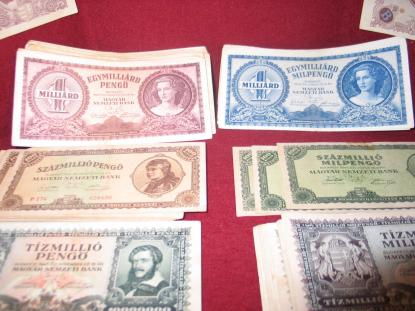2025. August 2. Saturday
Pál Kiss Museum - Tiszafüred
 |
Address: 5350, Tiszafüred Tariczky sétány 6.
Phone number: (59) 352-106
E-mail: kisspalmuz@gmail.com
Opening hours: Tue-Sat 9-12, 13-17
|
The exhibition has closed for visitors.
2011.11.02. - 2011.11.30.
Museum tickets, service costs:
|
Ticket for adults
|
500 HUF
|
/ capita
|
|
Group ticket for adults
(min. 10 people)
|
150 HUF
|
/ capita
|
|
Ticket for students
|
250 HUF
|
/ capita
|
|
Ticket for pensioners
|
250 HUF
|
/ capita
|
|
Ticket for families
(2 adults + max. 3 children)
|
750 HUF
|
/ family
|
|
Program ticket
|
300 HUF
|
/ capita
|
|
Season ticket
|
1000 HUF
|
|
|
Group guide
(max. 40 people)
|
2000 HUF
|
/ group
|
|
Photography
|
1000 HUF
|
|
|
Video
|
1000 HUF
|
This exhibition presents 189 banknotes, Hungarian pengoe ("pengő") of various values. These banknotes were issued by the Hungarian National Bank after the WW II.

After World War II the pengő lost value, suffering the highest rate of hyperinflation ever recorded in history. In the middle of 1945, the highest denomination was 10,000 pengő, but by the end of 1945, it was 10,000,000 pengő. At the beginning of 1946 banknotes of 100,000,000 and 1,000,000,000 pengő were introduced and the following denomination would have been banknote of 10,000,000,000 pengő which got the denomination of 10,000 milpengő. Milpengő was the abbreviation of 1,000,000 pengő. In March of 1946 new denomination was also introduced, the b.pengő (pronanciation bilpengő). It was 1,000,000,000 milpengő or 1,000,000,000,000 pengő or 1 billion pengő. These were used to alleviate calculations, cut down the number of zeros and enable the reuse of banknote designs with only the colour and denomination name changed. The highest denomination in mid-1946 was 100,000,000,000,000,000,000 pengő as the denomination of 1,000,000,000,000,000,000,000 pengő was only planned but it was not introduced. The rate of inflation was 1.3 x 1016 percent per month (prices double every 15 hours). When the forint was introduced in August 1946, 400,000,000,000,000,000,000,000,000,000 or 4x1029 pengő became 1 forint.
In the show-case banknotes are displayed in three columns. In the first column banknotes of 10,000, 100,000, 1,000,000, 10,000,000, 100,000,000 and 1,000,000,000 pengő can be seen. In the second column there are the denominations of milpengő (10,000 milpengő, 100,000 milpengő etc) and in the third column there are the denomination of b.pengő. Comparing the rows of columns visiton can realize the changes of denomination name (we miss banknotes of 100,000, 10,000,000, 100,000,000 and 1,000,000,000 bilpengő).

After World War II the pengő lost value, suffering the highest rate of hyperinflation ever recorded in history. In the middle of 1945, the highest denomination was 10,000 pengő, but by the end of 1945, it was 10,000,000 pengő. At the beginning of 1946 banknotes of 100,000,000 and 1,000,000,000 pengő were introduced and the following denomination would have been banknote of 10,000,000,000 pengő which got the denomination of 10,000 milpengő. Milpengő was the abbreviation of 1,000,000 pengő. In March of 1946 new denomination was also introduced, the b.pengő (pronanciation bilpengő). It was 1,000,000,000 milpengő or 1,000,000,000,000 pengő or 1 billion pengő. These were used to alleviate calculations, cut down the number of zeros and enable the reuse of banknote designs with only the colour and denomination name changed. The highest denomination in mid-1946 was 100,000,000,000,000,000,000 pengő as the denomination of 1,000,000,000,000,000,000,000 pengő was only planned but it was not introduced. The rate of inflation was 1.3 x 1016 percent per month (prices double every 15 hours). When the forint was introduced in August 1946, 400,000,000,000,000,000,000,000,000,000 or 4x1029 pengő became 1 forint.
In the show-case banknotes are displayed in three columns. In the first column banknotes of 10,000, 100,000, 1,000,000, 10,000,000, 100,000,000 and 1,000,000,000 pengő can be seen. In the second column there are the denominations of milpengő (10,000 milpengő, 100,000 milpengő etc) and in the third column there are the denomination of b.pengő. Comparing the rows of columns visiton can realize the changes of denomination name (we miss banknotes of 100,000, 10,000,000, 100,000,000 and 1,000,000,000 bilpengő).
